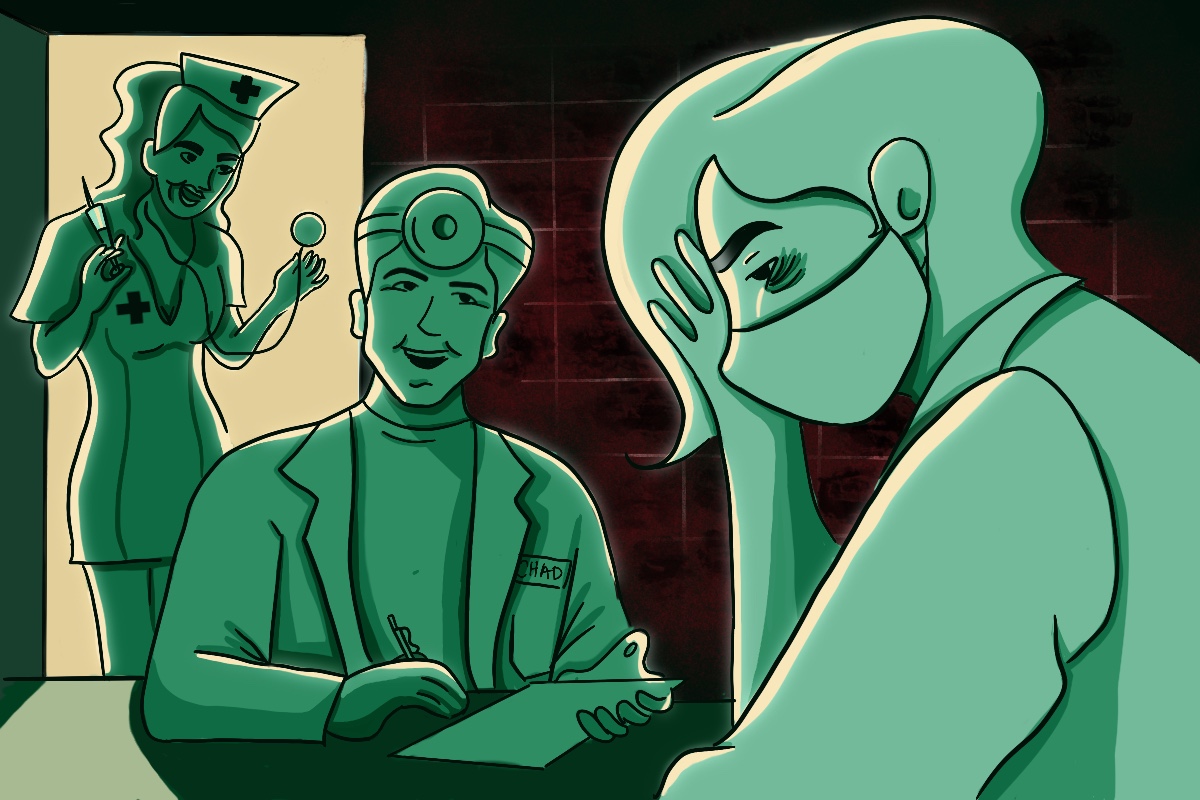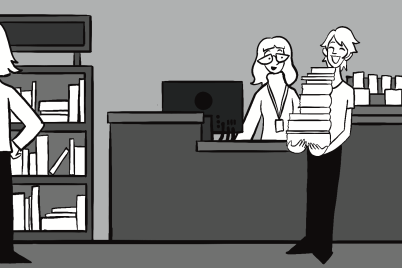
Illustration by Cassandra Stewart
 by JORDAN SCENNA
by JORDAN SCENNA
Deputy Editor
The following is what we like to call, “based on a true story.” It’s my experience of a recent bout with a nasty virus, and my subsequent attempt to get treatment. The pandemic has changed many cultural norms, from wearing masks in public places, to working from home. Getting sick, and going to see a doctor, isn’t what it used to be.
Today, we love to filter our images. We create our preferred versions of ourselves, and present that person to the world. We communicate an approximation of the truth. It’s life told through different lenses, and let me assure you, this tale is no different.
This particular incident is shaped by the lesser talked about symptom of any illness–other than amnesia, of course–an ailing memory.
After night-sweating through three shirts and dealing with a cough that was going from nagging to outright demanding, I decided to make a doctor’s appointment.
I went online to my provider’s website and scrolled down to my personal general practitioner, and saw that he didn’t have an opening for another week. No problem, he’s a busy doctor after all. I’ll just schedule an appointment with another provider in the office.
Lucky for me, I found an appointment the very next morning. I click on the time and a prompt comes up. “Are you experiencing any of these symptoms of COVID; sore throat, fever, cough fatigue?”
Yes, I click.
“This time isn’t reserved for people experiencing symptoms of COVID,” the website responds.
“Would you like to set up a video visit, the computer asks?”
Yes, I would, since I’m feeling sicker by the moment. I don’t know how you can properly diagnose me without a “can you take a deep breath,” or “open up and say ah,” but it’ll have to do. I click the little button for a welcomed video visit. The website explodes with pop-up boxes and red fonts. “No time available,” the computer shouts.
“Sorry,” I mutter. I feel like I’m bothering it.
“Oh well,” I think to myself as I cough up a dollop of yellow goo onto my shirt sleeve. There’s always Urgent Care, let me give them a call.
“The provider can see you as soon as he gets here,” says the nurse over the phone.
It’s 30 minutes past opening. The woman is calm and polite, as if the doctor’s tardiness isn’t out of the ordinary.
“Where is he,” I ask?
“I don’t know,” says the nurse. She’s probably not a nurse; more like nurse cosplay.
I’m parked in the alley behind Urgent Care, waiting to be seen by a provider. You can’t wait inside if you’re sick. I walked in and someone’s yelling at me.
“Have you experienced any of these symptoms in the past 48 hours; sore throat, fever, cough, fatigue.
“Yes,” I say, “that’s why I’m here.”
“Have you been in close contact with another person who’s tested positive for COVID?”
“Countless, I’m sure.”
“OK, please leave,” the woman wearing scrubs says, “and pull around back.”
“Around back,” I ask?
“Yes,” she says. “There’s an alley in the back.”
“Sure thing.”
I’m sitting in my car, half-conscious from illness and no-sleep, when I get a phone call from an unknown number.
“This is Robert, your provider, what are your symptoms?”
“Sore throat, fever, cough, fatigue.”
“It sounds like a respiratory infection, it needs to run its course. Go get some medicated cough drops.”
“What about a strep test,” I ask? “You haven’t even taken my temperature. Where are you?”
“I know what I’m doing,” the doctor reassures me.
“Do you have health insurance,” he asks?
“Yes.”
“That’ll be a hundred dollars.”
“But I have insurance,” I say.
“Yes,” he responds. “Is there anything else I can do for you?”
When I was a kid, my family doctor had a wonderful fish tank in his waiting room. The fish, covered in bright colors and swimming around their well-kept aquarium, soothed many a child’s flu. The doctor knew your name; knew your family. If necessary, they’d call in a prescription without you even having to go to the office. It’s what you might call health care.
Today, we’re left out in the cold; parked next to a large blue dumpster, and made to stare at a brick wall while trying not to vomit in our car. All for the price, of what is for some, an entire day’s pay.
Doctors are often referred to as providers, but too often, all they provide is another headache. Between overpriced treatments, insurance hassles, and backdoor deals with drug companies, patients have been transformed into numbers.
With other news grabbing headlines, like Ukraine or Hunter Biden’s laptop, the discussion about health care reform has all but vanished. The fractures in our system are only examined every few years, usually just in time for the next election; and then, poof, it’s gone, like a miracle. Everyday people put off seeing a doctor whether because of cost or quality of care.
We can do better.


